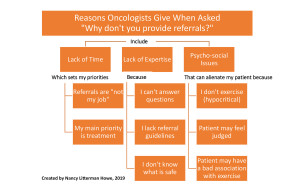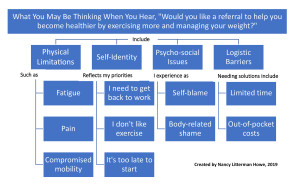As of 2020, more than 60, yes 60, clinical practice guidelines published by experts in the disciplines of oncology, exercise science, and physical rehabilitation recommend that cancer survivors like us should receive referrals to cancer rehabilitation and exercise services. Up to 80% of survivors like us want to learn more about exercise and are waiting for our clinicians to start the conversation about how to become more active. But of all of us survivors who could be helped by cancer rehabilitation services, fewer than 10% of us are receiving them. Why is this?
The Crux of the Problem:
The Cancer Rehab Conversation
Between Survivor and Oncologist Isn’t Happening
Why isn’t the conversation happening? Not surprisingly, oncologists give some very good reasons why they are reluctant to offer exercise advice. (Click on the orange graphic to enlarge.)
There are equally good reasons why cancer survivors tend to avoid the subject. (Click on the blue graphic to enlarge.)
The benefits of physical activity are real for survivors who are able to exercise and who have access to a safe and effective exercise program. But for many of us, cancer rehab is needed to address pre-existing health issues, functional impairments, and debilitating early effects of treatment such as fatigue, pain, chemotherapy-induced peripheral neuropathy, lymphedema, depression, and muscle weakness. Without addressing these issues, exercise is just not possible no matter how many times a provider tells you that exercise is beneficial.
So here we are, survivors who need and want rehabilitation services and help to start an exercise program, but left on our own. And crushingly, cancer rehabilitation MDs and therapists who have the training to help us sit waiting for the referrals that never come.


 Stay posted Here
Stay posted Here